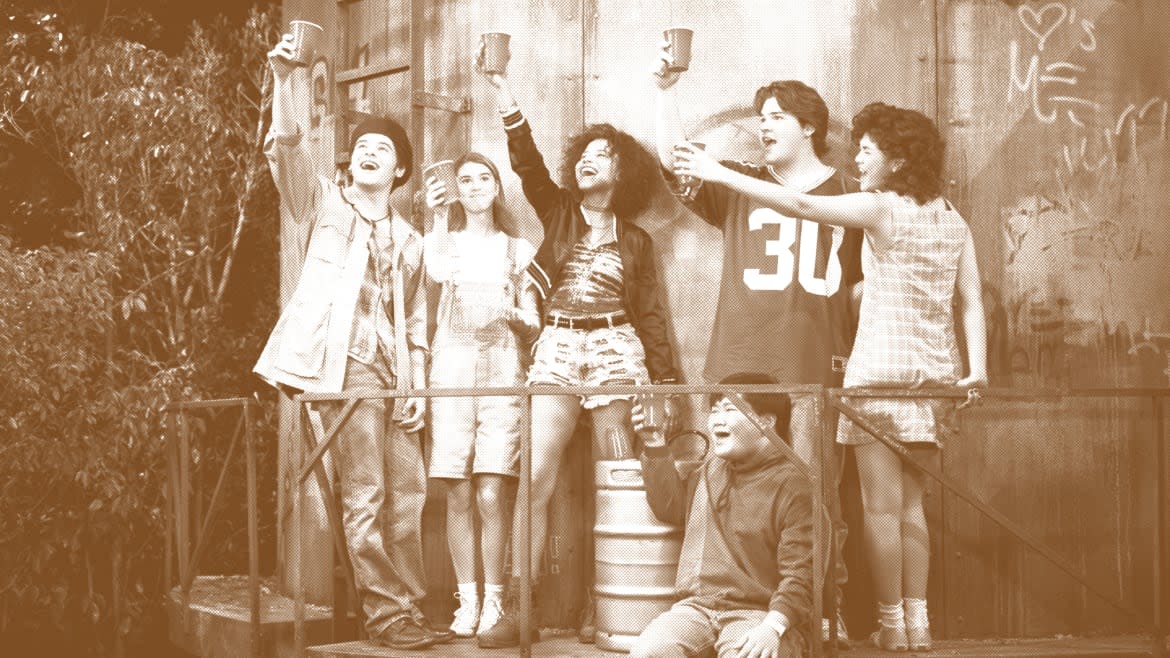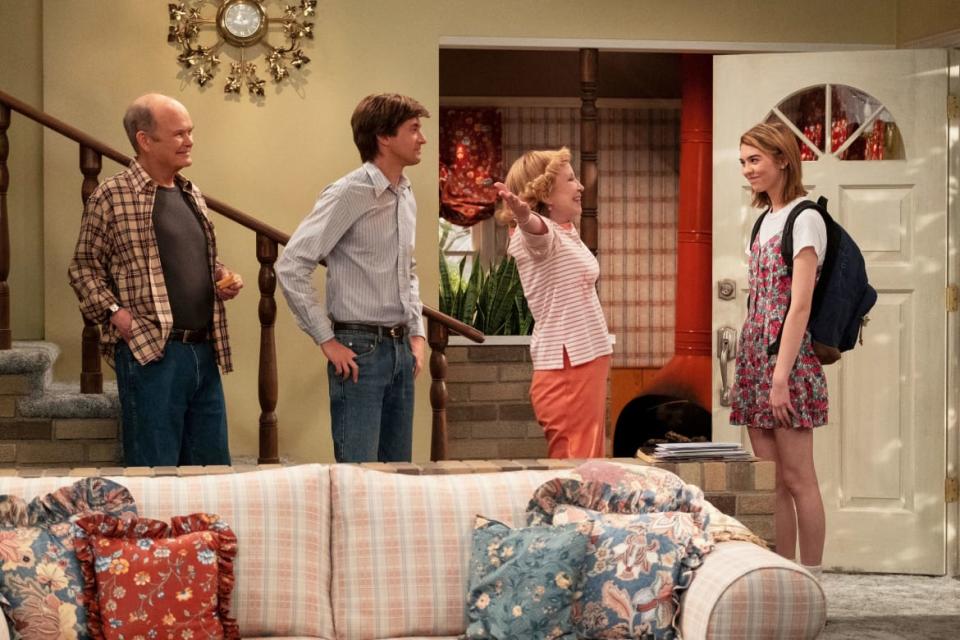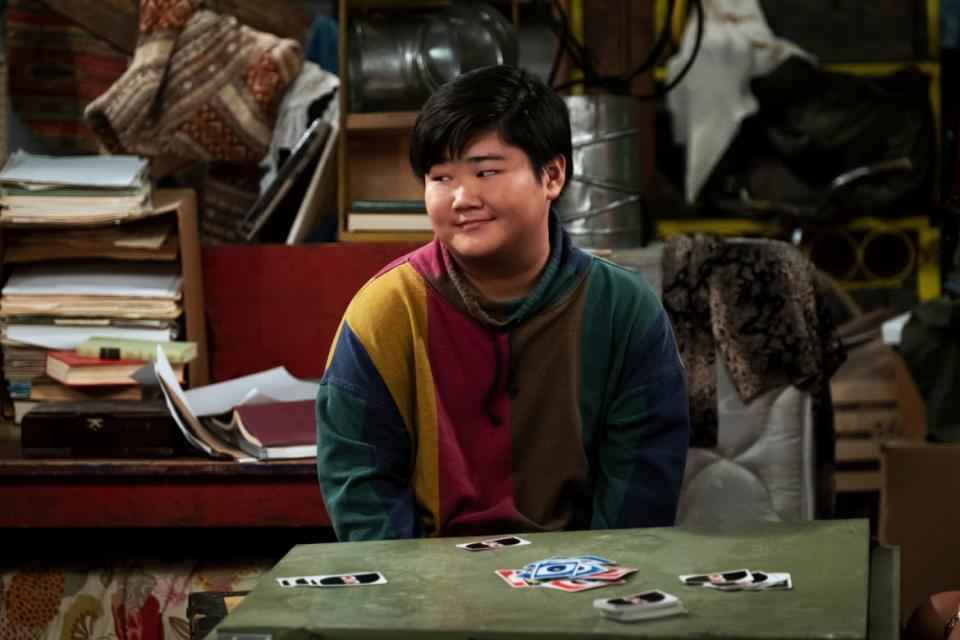‘That ’90s Show’ Is a Cynical Trainwreck: Everything That Annoyed Me About It

- Oops!Something went wrong.Please try again later.
There’s a moment in That ’90s Show when Bob Pinciotti—father to Laura Prepon’s That ’70s Show character, Donna—serenades his granddaughter with an incredibly inappropriate ballad. It’s the kind of moment that would have felt right at home in the original series, but sadly, it doesn’t quite hit the same now. The scene, like much of the show that contains it, feels more akin to taking a puff of desperation from a moldy old joint.
There was no familiar high as I watched a jerry-curled Don Stark bleat out Boyz II Men’s “I’ll Make Love to You” to his granddaughter, Leia Forman. Instead, I felt a strange moment of synchronicity with that poor, mortified teenager. Like her, I was witnessing a complete collapse of media comprehension. That ’90s Show is a failure to read the room on par with Crystal Pepsi—a transparent, poorly branded failure that leaves a depressing taste in the mouth.
The most instantly noticeable mistakes in That ’90s Show come down to casting and writing. The original That ’70s teens had the kind of chemistry that most casting agents only dream about. One would have thought that in this go-around, painstaking efforts would have been made to ensure that the new kids of Point Place, Wisconsin would have the same rapport. Sadly, Netflix did not bother to do this; in place of a hodge-podge of complementary misfits, we get a roomful of teens whose reasons for hanging out together are borderline impossible to fathom.
Consider, for instance, the way Leia Forman—Eric and Donna’s dorky daughter, predictably named after a certain Star Wars princess—meets her first friend in Point Place. When she and her parents stop by for a visit ahead of a father-daughter trip to space camp, Leia wanders off to spy on a Cool Girl™ next door, whom she hears jamming out to Alanis Morissette. When said neighbor—Gwen, played by Ashley Aufderheide—catches her, they become friends without incident because despite being a voyeur and a dork, Leia happens to have a bootlegged CD from Chicago. How does that work?
While we’re asking questions: Why is the driven and studious Nikki (Sam Morelos) actually interested in her blandly rendered jock boyfriend, Nate (Maxwell Acee Donovan)? That ’90s Show seems to believe that if viewers see them make out enough, they’ll believe the relationship—but as Ashton Kutcher and Mila Kunis’ Michael and Jackie from the original can tell you, the key to a good TV relationship is all about the romantic tension, and these two simply do not have it.

Kurtwood Smith as Red Forman, Topher Grace as Eric Forman, Debra Jo Rupp as Kitty Forman, Callie Haverda as Leia Forman in episode 101 of That ‘90s Show.
And speaking of Kelsos: Is Jay Kelso (son of Michael and Jackie, and the hunk of the group) supposed to be, like, likable? Because as he exists in this series, he’s mostly just oiled up and oafish. Not exactly a heartthrob. Also, what ever happened to Kelso’s daughter, Betsy, and her mother Brooke? How are Kelso and Jackie together after ending the series in different relationships? Does Fez still carry a torch for Jackie? God knows we’re not mentioning her past relationship with Hyde—or Hyde himself, for good reason—but are we really going to pretend like Betsy and Brooke never happened? As Kelso himself might say: burn?
It should come as no surprise, given how little care appears to have been put into constructing these new characters and arcs, that That ’90s Show’s familiarity with the ’90s is facile at best and pure revisionist dreaming at worst.
Gwen might invoke the Riot Grrrl Manifesto, but she also admits to having only skimmed it—which is basically what the series does with ’90s culture writ large. Save for a horrendously distracting wig on Morelos, pretty much all of the costumes seen here could be purchased on Shein. (Save, perhaps, for Nate, whose devotion to jerseys as fashion statements does feel very ’90s.) Rather than engage with what life was actually like at the time, That ’90s Show grafts old references onto what otherwise could be a modern setting: Zima! Bill Clinton on Arsenio! Flannel! Alanis!
‘That ’90s Show’ Is Worse Than ‘That ’70s Show’ in Every Way
It’s a cruel irony that ’90’s one entertaining addition to the That ’70s Show universe also happens to be its most implausible: As Ozzie, actor Reyn Doi is a charismatic force. His comedic timing is killer, and his consistently sharp line deliveries breathe life into an otherwise narcoleptic script. Unfortunately, given the setting, this character makes little to no sense.
That ’90s Show likes to imagine a kinder version of its time period. The show’s vision of suburban Wisconsin is diverse and accepting—so much so that Ozzie, a young gay teen, is out to all of his friends and has a multi-step plan to eventually come out to everyone else. On one hand, it’s heartwarming to see this character on screen. But this approach also threatens to erase the grim realities of those times—realities that continue to influence the present.

Reyn Doi as Ozzie in episode 101 of That ‘90s Show.
There’s a reason that Friends—a series that actually aired in the ’90s—spent nearly its entire run pretending that Black people don’t exist in New York. The term “superpredator” spread like wildfire in the mid-90s, raining terror on a generation of Black youth. Ellen DeGeneres lost her show and almost her career because she came out on television as a fictionalized version of herself; televangelist Jerry Falwell branded her “Ellen DeGenerate,” a nickname that became popular among bigots far and wide. It wasn’t until the late 2000’s that an ad campaign began to push back against phrases like “That’s so gay!”
It’s more pleasant to imagine a version of the ’90s (or today) in which suburban Wisconsin is not so lily-white. It’s soothing to picture the ’90s as a time shaped by pop hits and novelty soft drinks instead of repressive policies like the 1994 crime bill, the Defense of Marriage Act, and Don’t Ask, Don’t Tell. And it’s cathartic, to a point, to see a young gay teenager coming into his own in such a place—without the fear and internalized shame many of us real-life former queer kids of the ’90s used to carry. But who, or what, are these warm, fuzzy, soft-focused dreams of our collective past really helping?
That ’90s Show only feels more cynical once Fez shows up. If the argument for including an anachronistic character like Ozzie that doing so helps right the problematic wrongs of the past, why is Wilmer Valderamma’s heavily accented foreign exchange student still as stereotypical as ever? In fact, the primary joke about Fez throughout the new series remains his feminized presentation—a punchline one would think we’d be leaving behind if we’re trying to take a more enlightened view on sex, sexuality, and gender.
‘The Real Friends of WeHo’ Is a Colossal Gay Nightmare
But Hollywood has a talent for self mythology, and one of the entertainment industry’s greatest tricks over the years has been convincing a generation of viewers that representation produces real social progress when in reality, it’s merely a symptom of progress made elsewhere. Another Netflix series, Ryan Murphy’s Hollywood, was emblematic of that pernicious idea: the series creates a fantasy of Tinseltown’s Golden Age in which everyone can find acceptance and recognition. It’s a pleasant fantasy, but just like That ’90s Show, it’s also an empty one that does more to obscure the wrongs of the past than to fix them in the present.
In That ’90s Show’s case, this might all be an overreaction. Even as a devout buzzkill, I recognize that this show is, at its core, a ho-hum revival of an excellent but mostly ordinary sitcom. But there’s something insidious about projects like these—lazy half-remembrances of the past that invite us to reduce our cultural history to a collectible stack of song titles and products while sweeping all the bad stuff under the indoor-outdoor carpeting. It’s a great ploy for media executives, who remain overwhelmingly white and straight and wealthy enough to be removed from the issues that underpin everyday life in the real world. But what’s it doing for everyone else?
Keep obsessing! Sign up for the Daily Beast’s Obsessed newsletter and follow us on Facebook, Twitter, Instagram and TikTok.
Get the Daily Beast's biggest scoops and scandals delivered right to your inbox. Sign up now.
Stay informed and gain unlimited access to the Daily Beast's unmatched reporting. Subscribe now.

